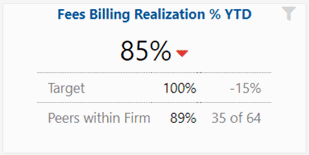Translating work undertaken into revenue as quickly as possible is vital to ensure your law firm’s financial success. Realization is one of a number of measures that can be used to analyze the decisions being made within your firm. Even a small uptick in realization levels can make a big difference when it comes to measuring your profits.
A variety of factors can affect realization, so it’s important to determine which best reflects the scenario you are looking to measure. Here are three of the most commonly used measures:
Standard Billing Realization (%)
Standard Billing Realization measures the value of fees billed versus the standard rate for each of your lawyers. It is not uncommon for lawyers to provide a discount when the client either requests or demands one, and this approach to measuring realization considers this occurrence.
Your Standard Billing Realization can be calculated by taking the value of total fees billed and dividing it by the standard fees value of time billed to date.
For example, if a lawyer’s standard rate is 500 per hour and they worked 10 hours, this would equate to a standard value 5,000. If the lawyer has agreed to a discounted rate of 450, this would equate to a billable fees amount of 4,500. On the face of it the Standard Billing Realization would be 90%. (4,500 / 5,000) * 100.
However, discounts often apply not only to the initial up front agreed-upon rates, but also during the process of making billing decisions. As such, if the lawyer elected to bill the time at a reduced amount of 4,250 this would lower the Standard Billing Realization to 85%. (4,250 / 5000) * 100.
Fees Billing Realization (%)
Fees Billing Realization measures the value of fees billed versus the value of billable fees for each of your lawyers. If a discount has been agreed as part of client-onboarding, this approach to measuring realization evaluates the level of discounting against the agreed client and matter rates.
Your Fees Billing Realization can be calculated by taking the value of total fees billed and dividing it by the value of billable fees of time billed to date.
For example, if a lawyer is working on a matter with an agreed client rate of 450 per hour and they worked 10 hours, this would equate to a billable fees value of 4,500. If the lawyer elected to bill the time at a reduced amount of 4,250, this would lower the Fees Billing Realization to 94.4%. (4,250 / 4,500) * 100.
Fees Collected Realization (%)
Fees Collected Realization measures the value of fees collected versus the value of billed fees for each of your lawyers. This approach to measuring realization is designed to measure the impact of write-offs and, to some degree, considers how quickly clients settle their account.
Issuing a high level of write-offs (or credit notes) can indicate that clients are unhappy with your service, and has an obvious impact on your bottom line.
Your Fees Collected Realization can be calculated by taking the value of total fees billed and dividing it by value of fees collected of time billed to date. In some cases, you may also choose to apply a time frame to the calculation (e.g. 45 days) to measure the impact this has on your cash flow.
For example, if a lawyer has billed a value of 4,250 and the client has paid 3,750 to date and requested the firm raise a write-off for the remaining 500, the Fees Collected Realization would be 88.2%. (3,750 / 4,250) * 100.
Keeping It Simple

Once you have chosen the metrics which best match the circumstances you are looking to measure, it’s important to reflect them clearly to your audience.
The above example does this using the following approach:
- The primary measure of 85% is clearly presented
- The trend indicator is showing that this is trending downwards over the last 12 months
- The firm has set a target of 100%, but each firm’s individual target may vary
- The result is compared to a set of defined peers (for example all Matter Billing Partners) to encourage healthy competition through comparison
Get the BI Platform to Track Your Firm’s Most Important Metrics
If your law firm has been looking for a better BI solution, we can help – request a demo today. By configuring our platform, you will see the metrics most important to you using your choice of a cube or dashboard. We know what law firms are looking for, and we have created a solution that provides a complete BI framework for all firm analysis needs.







